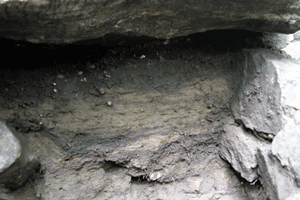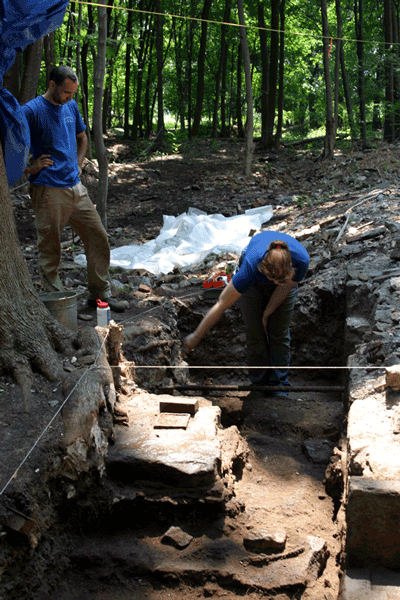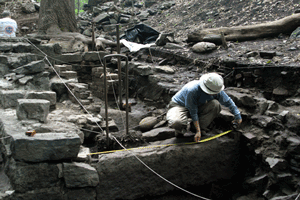| 2004
Field School & Industrial Archaeology Project-West Point Foundry Michigan Technological University |
| Posting
July 11, 2004 by Suika M. Rivett
|
| Industrial
Detectives Week eight
here at the West Point Foundry has been an exciting one. We
continue to unearth artifacts and structures that answer important
questions in two areas of the foundry complex. In the Blowing
Engine area, machinery blasted air into the furnace to smelt
iron from ore. In the Boring Mill area, foundry workers bored
and rifled cannons and steam engine cylinders. Rachael Herzberg
and Erin Timms have posed research questions that will lead
to MTU Industrial Archaeology masters theses about the West
Point Foundry. |
| Erin
Timms’ research focuses on the operations at the blast furnace.
She is interested primarily in the blowing engine and the water system
that powered it. One of Timms’ primary questions pertains to
the curious water system that, as seen in historic maps, appears to
run beneath the furnace and into a battery pond nearby. Water was
undesirable in the area of furnaces as it could turn to steam and
cause damage. Since most furnaces are built as far from water as possible,
Timms set out to determine whether this was actually the case. Some
of the findings this week, such as thin layers of sand and other soils
apparently deposited by water in a channel near the furnace, suggest
that water may have been routed beneath the furnace. |

Soil
stratigraphy under the southern lintel in the Blowing Engine. |
| Students
and volunteers have
been unearthing
structural foundations and artifacts in excavation units located
north of the blast furnace for most of the summer. These excavations
unearthed lintel stones in two units; the lintel stones (one to
the north and one to the south) are supported by other stones beneath
them, forming an opening beneath them. Suspecting that these might
be the openings for a headrace or tailrace from the waterwheel of
the blowing engine, Timms probed beneath the southern lintel to
see how far the openings might go. This probing established that
the opening beneath the southern lintel extends at least eleven
feet beneath stone walls and likely connects with the opening identified
to the north.
In this same week, revealing artifacts have been unearthed in excavations at the boring mill. During a recent visit to the site, Vance Packard, Jr., past president for SIA (Society for Industrial Archeology), identified similarities between a historic photograph possibly taken inside the boring mill and an area currently being excavated. The photograph depicted the operation of a wheel lathe—a device capable of moving two dimensionally to correspond to the height and width requirements of the wheel being machined. Three walls, a deep lathe bed, and a crane depicted in the historic photograph correspond to structures located in areas being excavated in the boring mill. Rachael Herzberg, whose thesis research focuses on the boring mill, began further excavations in the area in order to determine if this truly was the area of the wheel lathe. Crew working in new excavation units uncovered two key artifacts that may prove that the photograph may depict the spot we are digging now. Those artifacts include a complete gear rail (a flat-toothed gear that a round toothed gear would have moved horizontally or vertically on) and a large clamp possibly used for securing the work being machined.
Erin taking measurements off of the northern lintel in the Blowing Engine. |

Suika & Paul in the Boring Mill relate the pipe to the wall construction. Additional excavation in both the Blowing Engine and the Boring Mill look promising for more pertinent finds in the weeks to come – updates to follow. Suika M. Rivett |
Email | Phone: (906) 487-2113 | Fax: (906) 487-2468
